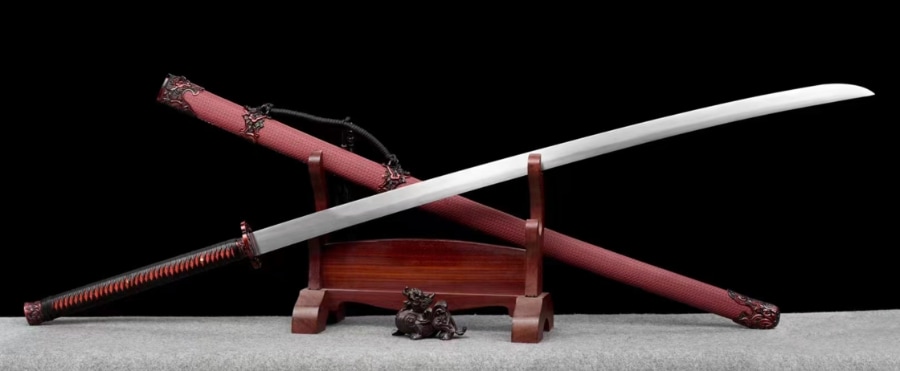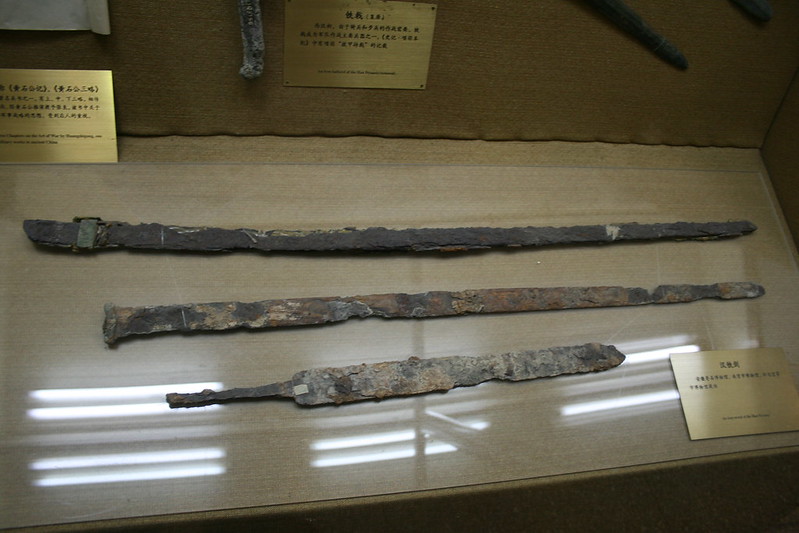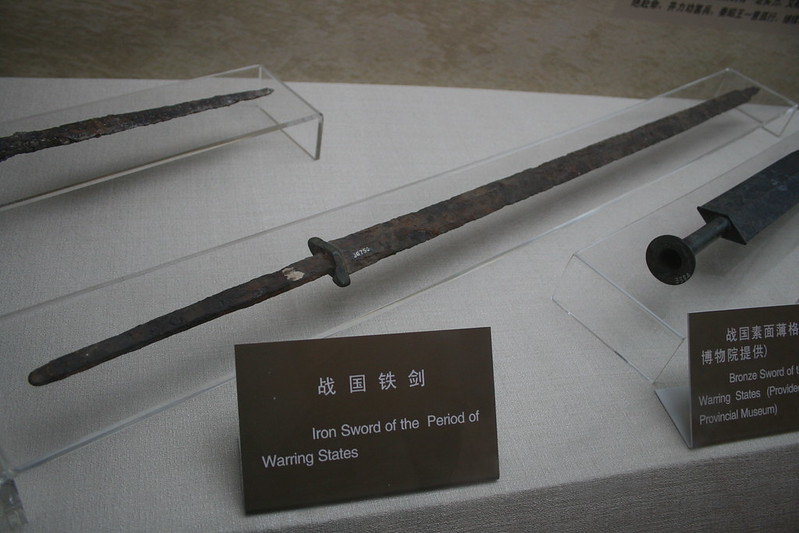
Shuangshou dao 雙手刀 – the Chinese two-hand sword
The shuangshou dao 雙手刀, or two-handed sword, shares historical parallels with the development of two-handed jian 劍 but has a distinct history rooted in the evolving needs of Chinese warfare. This is an overview of how two-handed dao 刀 developed, including their presence during the Qin 秦 (221-206 BC) and Han 漢 (206 BC – 220 AD) eras and how they diverged from two-handed jian 劍.
Early Qin 秦 (221-206 BC) and Han 漢 (206 BC – 220 AD) Eras: Proto-Two-Handed Dao 刀
In the Qin 秦 and Han 漢 dynasties, two-handed swords – particularly sabers – were relatively rare. While one-handed dao 刀 were gaining popularity due to their effective slashing capabilities, lower cost, and ease of production compared to jian 劍, long-handled bladed weapons resembling sabers began to emerge. These were more akin to polearms with long blades rather than true two-handed dao, primarily because the technology and battle tactics didn’t yet fully accommodate wielding large, two-handed cutting blades on foot.
The Qin 秦 dynasty’s military reforms under EmporerQin Shi Huang 秦始皇 (259-210 BC) established a standardisation in weaponry, but the focus remained largely on single-handed dao 刀 and polearms like the ge 戈 (dagger-axe) and ji 戟 (halberd). This practical approach suited Qin’s 秦 (221-206 BC) dense infantry formations, where a single-handed dao 刀 was more maneuverable and fit better with shields.
In the Han 漢 dynasty (206 BC – 220 AD) , iron and early steel swords continued to improve, and longer, heavier dao 刀 began to appear, although these were more commonly used as cavalry weapons or among elite troops. While true two-handed dao 刀 were not yet standard, weapons like the changdao 長刀 (long dao), used by cavalry and later foot soldiers, showed the early formation of two-handed saber techniques.
Tang 唐 (618–907 AD) Dynasty and Later: Formalisation of the Two-Handed Dao 刀
It was during the Tang 唐 (618–907 AD) and Song 宋 (960–1279 AD) dynasties that the two-handed dao 刀 began to take a more defined form. By this time, Chinese military strategy had evolved to incorporate more open-field battles, where the two-handed dao 刀 could leverage its reach and power, especially against armoured cavalry.
The Ming 明 (1368–1644 AD) dynasty saw significant formalisation of the two-handed dao 刀, such as the changdao 長刀 and miao dao 苗刀, which gained tactical importance against enemy forces like Japanese pirates or wakou 倭寇, and Mongol cavalry. Ming 明 General Qi Jiguang 戚繼光 (1528–1588) famously incorporated two-handed dao 刀 into his military reforms, training infantry to wield them in formations specifically developed to counteract the speed and armour of invading forces.
Qing 清 (1644–1912 AD) Dynasty and Beyond: The Miao Dao 苗刀 and Martial Arts Tradition
By the Qing 清 (1644–1912 AD) dynasty, two-handed dao 刀 like the miao dao 苗刀 were mostly relegated to specialised units or used in ceremonial and training contexts rather than widespread battlefield use. They became favoured in certain martial arts schools for their powerful, sweeping cuts and the ability to combine power with flexibility, a legacy that has carried into modern martial arts.
Today, two-handed dao 刀 such as the miao dao 苗刀 are preserved in traditional Chinese martial arts, embodying centuries of battlefield experience and evolving swordsmanship techniques that began to take form as early as the Qin 秦 (221-206 BC) and Han 漢 (206 BC – 220 AD) dynasties. These long-handled sabers offer unique insights into Chinese military history, where adaptability and refinement led to a distinctive class of weapons suited for both individual prowess and collective defence.

Han 漢 (206 BC – 220 AD) ‘Two-handed’ Iron Sword. Beijing Military Museum: Ancient Weapons Exhibition. Image credit: Gary Lee Todd PhD.

Warring States period (475–221 BCE) ‘Two-handed’ Iron jian 劍. Beijing Military Museum: Ancient Weapons Exhibition. Image credit: Gary Lee Todd PhD.
References:
The following are some recommended Chinese references that cover the history and development of Chinese weapons, including the two-handed dao 雙手刀, with discussions on military strategy and the evolution of Chinese swordsmanship. These sources offer in-depth perspectives on early Chinese martial weaponry and the historical contexts of the Qin 秦, Han 漢, Tang 唐, Song 宋, Ming 明, and Qing 清 dynasties:
-
《中國古兵器圖集》 (Illustrated Compendium of Ancient Chinese Weapons)
Author: 陳正雷 (Chen Zhenglei)
This work provides a comprehensive look at various Chinese weapons, with illustrations and descriptions of sabers, swords, polearms, and their evolution through different dynasties. It explores the distinctions between one-handed and two-handed blades and the contexts in which they were used. -
《中國武術史》 (History of Chinese Martial Arts)
Author: 唐豪 (Tang Hao)
A foundational text on the history of Chinese martial arts, this book covers the development of weaponry in martial traditions and the influence of historical changes in warfare on the techniques and types of swords, including two-handed dao 刀. -
《中國冷兵器戰爭史》 (History of Cold Weapon Warfare in China)
Author: 王兆春 (Wang Zhaochun)
This historical survey examines cold weapons used in Chinese warfare from ancient to late imperial China. It includes insights into military strategy and technological advancements that led to the use of long, two-handed weapons like the changdao 長刀. -
《中國刀劍簡史》 (A Brief History of Chinese Swords and Sabers)
Author: 李修文 (Li Xiuwen)
This book focuses specifically on Chinese swords and sabers, addressing the transition from single-handed to two-handed weapons and how these weapons developed to fit different military roles from the Han 漢 dynasty onward. -
《戚繼光兵書》 (Military Writings of Qi Jiguang)
Author: 戚繼光 (Qi Jiguang)
This collection contains Qi Jiguang’s 戚繼光 military writings, including his insights on training soldiers with the changdao 長刀. His writings remain some of the most authoritative sources on Ming 明 military strategy and the tactical use of two-handed weapons. -
《武備志》 (Treatise on Military Preparations)
Author: 茅元儀 (Mao Yuanyi)
Compiled in the late Ming dynasty, this treatise is an encyclopedic source on Chinese military science, covering weaponry, tactics, and formations. It includes discussions of various weapons, including two-handed dao, and their strategic applications. -
《中國古代兵器史》 (History of Ancient Chinese Weapons)
Author: 戴鴻森 (Dai Hongsen)
This detailed study explores the development of ancient Chinese weapons, examining archaeological finds and historical records that document the evolution of two-handed dao 刀 and other long weapons.
